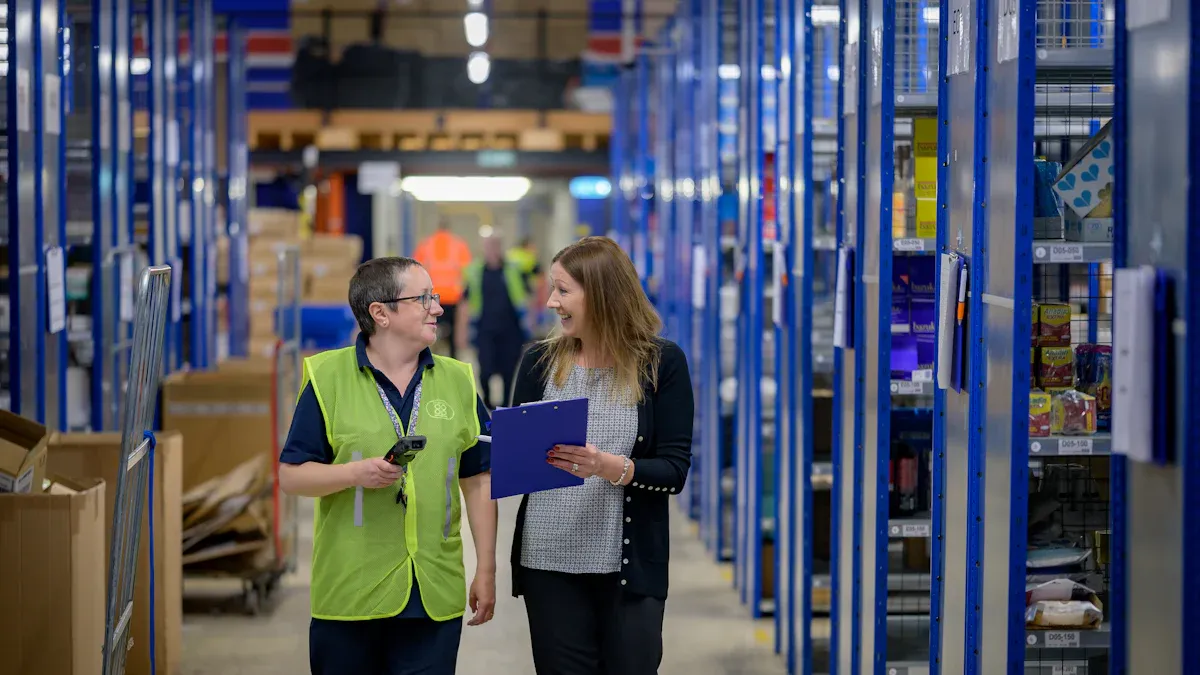5 Ways to Get More Efficiency From Your Fulfillment Facility

When it comes to running a fulfillment facility, efficiency isn’t just a nice-to-have—it’s a game-changer. It can slash operating costs and boost customer satisfaction in ways you might not even realize. Did you know that the last mile of an e-commerce order makes up 41% of total supply chain costs? That’s a huge chunk you can trim down with smarter operations. And here’s another eye-opener: over 50% of online shoppers abandon their carts if their orders can’t be fulfilled within a week. If you want to get more efficiency out of your facility, it’s time to rethink how you manage your space, people, and processes.
Key Takeaways
Keep your inventory neat and easy to find. Put popular items where workers can grab them quickly to save time and avoid mistakes.
Use a Warehouse Management System (WMS). This tool helps you check stock and handle orders faster and more accurately.
Train workers to do different jobs. This makes your team ready for surprises and ensures important work always gets done.
Watch important numbers like how fast and accurate orders are. Checking these numbers helps you see what’s working and what needs fixing.
Help teams work well together. Good communication cuts down delays and makes your facility run better.
Streamline Your Warehouse Layout to Get More Efficiency

Organize Inventory for Easy Access
If your inventory isn’t organized, you’re wasting time and money. Imagine trying to find a needle in a haystack every time you process an order. By organizing your inventory for easy access, you can speed up order fulfillment and reduce errors. Start by placing your top-selling items in the most accessible locations. This way, your team spends less time searching and more time picking.
Grouping similar products together also helps. For example, if you sell electronics, keep chargers near phones and laptops. A centralized inventory management system can make this even easier by providing real-time updates on stock levels. This reduces stockouts and overstocks, ensuring you always know what’s available.
Implement a Logical Flow for Picking and Packing
A logical flow in your warehouse can make all the difference. Think of it like a well-oiled machine—every part works together seamlessly. Start by placing high-turnover items closer to packing stations. This minimizes the distance your team needs to travel, saving time and energy.
Consider using class-based inventory management. Group items by shared traits, like size or category, to streamline the picking process. Mobile shelf-based systems are another game-changer. Robots can bring shelves directly to your pickers, speeding up the process and reducing human error.
Studies show that chaotic inventory management—where items are stored based on algorithms rather than fixed locations—can also improve picking accuracy. It disrupts assumptions about item placement, leading to fewer mistakes.
Use Space-Saving Storage Solutions
Maximizing your warehouse space isn’t just about cramming more items in—it’s about smarter storage. Mobile racking systems, for instance, reduce aisle space when not in use, giving you more room for inventory. Vertical Lift Modules (VLMs) take advantage of unused vertical space, delivering items at ergonomic heights for faster retrieval.
A Warehouse Management System (WMS) can optimize space utilization by analyzing real-time data. It ensures every square foot is used efficiently, boosting productivity. Enhanced retrieval times and reduced labor costs are just some of the benefits of these solutions.
Here’s a quick comparison of space-saving options:
Storage Solution | Benefits |
|---|---|
Increases storage capacity by reducing aisle space and allows easy access to items. | |
Vertical Lift Modules (VLMs) | Maximizes vertical space, improves retrieval efficiency, and enhances organization. |
Warehouse Management Systems (WMS) | Optimizes space utilization and improves retrieval efficiency through real-time data. |
By implementing these strategies, you’ll not only get more efficiency out of your warehouse but also create a smoother workflow for your team.
Leverage Technology and Automation for Efficiency Gains

Invest in Warehouse Management Systems (WMS)
A Warehouse Management System (WMS) is like the brain of your fulfillment facility. It helps you track inventory, manage orders, and optimize workflows—all in real time. With a WMS, you can reduce errors and improve order accuracy, which means fewer headaches for you and happier customers.
These systems also make scaling your operations a breeze. Whether you're handling 100 orders or 10,000, a WMS ensures everything runs smoothly. Companies like Amazon use data-driven insights from their WMS to place inventory strategically, speeding up deliveries and cutting costs.
Here’s how technology boosts efficiency:
Benefit | Description |
|---|---|
Enhanced Precision | Automation improves accuracy in order fulfillment, reducing errors. |
Technologies like AGVs and AMRs boost picking speeds by 30%. | |
Boosted Scalability | Automation allows facilities to scale operations efficiently. |
Elevated Productivity | Robotics and AI lead to productivity increases of 25% to 70%. |
Reduced Operational Costs | Automation can cut costs by 20% to 40%, enhancing overall profitability. |
Use Automated Picking and Packing Systems
Automated picking and packing systems are game-changers for fulfillment facilities. These systems reduce processing time per order to just 22 minutes, making your operations faster and more efficient. They also optimize workflows by strategically placing conveyors to minimize walking distances for employees.
If you’re dealing with high order volumes, automation can handle the pressure. Machines like the Packsize X5 produce up to 600 boxes per hour, ensuring you meet demand without breaking a sweat. By integrating these systems, you’ll get more efficiency out of your facility while keeping your team focused on higher-value tasks.
Implement Barcode Scanning and RFID Technology
Barcode scanning and RFID technology take inventory management to the next level. Traditional methods, like manual counting, only achieve about 63% accuracy. RFID, on the other hand, can boost accuracy to an impressive 99.9%.
This level of precision doesn’t just save time—it can also increase sales. When you know exactly what’s in stock, you can fulfill orders faster and avoid disappointing customers. Companies that adopt RFID see inventory count accuracy improve from 65% to over 95%, making it a must-have for modern fulfillment facilities.
Here’s why RFID stands out:
High inventory accuracy leads to better sales opportunities.
Manual counting methods average just 63% accuracy.
RFID technology achieves up to 99.9% accuracy.
Companies using RFID see accuracy jump from 65% to over 95%.
By leveraging these technologies, you’ll streamline operations, reduce errors, and create a more efficient fulfillment process.
Optimize Labor Management to Get More Efficiency
Cross-Train Employees for Versatility
Cross-training your employees is one of the smartest moves you can make to boost efficiency. When your team knows how to handle multiple roles, you’re better prepared for unexpected challenges like staff shortages or sudden spikes in demand. For example, if a picker calls in sick, a cross-trained packer can step in without disrupting the workflow.
This versatility doesn’t just keep operations running smoothly—it also improves productivity. Employees can be deployed where they’re needed most, ensuring essential tasks are always covered. Plus, cross-training reduces your reliance on specific individuals, so work continues even if someone is unavailable.
Here’s why cross-training works:
Employees can fill in for absent coworkers, minimizing disruptions.
Teams become more adaptable to changes in demand or workflow.
It prepares your staff to handle bottlenecks and unexpected situations.
By investing in cross-training, you’ll get more efficiency out of your workforce while creating a more resilient operation.
Use Data to Schedule Shifts Effectively
Scheduling shifts isn’t just about filling time slots—it’s about aligning your workforce with demand. Using data-driven insights, you can identify peak order times and ensure the right number of employees are available when you need them most. This prevents bottlenecks during busy periods and minimizes idle time during slower ones.
Workforce management software can help you analyze performance metrics and optimize schedules. For instance, automated systems can log real-time data, compare schedules, and even gather employee feedback to improve shift planning. Balancing efficiency with employee satisfaction is key. When your team feels valued, they’re more likely to perform at their best.
Evidence Type | Description |
|---|---|
Automated Performance Logging | Captures real-time metrics directly from the scheduling system without manual intervention. |
Schedule Comparison Analysis | Contrasts algorithm-generated schedules with manually optimized versions to identify gaps. |
Employee Feedback Surveys | Collects structured input from staff about schedule quality and preference accommodation. |
Management Reporting | Gathers insights from supervisors about operational impacts of generated schedules. |
Time and Attendance Integration | Links actual punch data with scheduled shifts to measure adherence and accuracy. |
When you use data to schedule shifts effectively, you’ll see measurable gains in fulfillment speed and accuracy.
Provide Ongoing Training and Incentives
Your team is your greatest asset, and investing in their growth pays off big time. Regular training sessions keep employees up-to-date on best practices and new technologies, ensuring they’re always ready to perform at their peak. For example, companies that offer structured product training report higher customer satisfaction and retention rates.
Incentives are equally important. Recognizing hard work with rewards—like bonuses or extra time off—motivates employees to go the extra mile. Studies show that quality training and incentives reduce turnover and improve job satisfaction, leading to better overall performance.
Evidence Type | Description |
|---|---|
Case Study | Companies that implemented structured product training saw significant improvements in sales performance and customer satisfaction. |
Research Finding | Firms reported a 25% increase in customer retention attributed to effective product training focused on interpersonal skills. |
Empirical Evidence | Studies indicate that quality training reduces employee turnover and enhances job satisfaction, leading to better performance. |
By combining ongoing training with meaningful incentives, you’ll create a motivated, skilled workforce that drives efficiency in your fulfillment facility.
Monitor and Analyze Key Performance Metrics
Track Order Accuracy and Fulfillment Speed
Tracking key metrics like order accuracy and fulfillment speed is essential for running a smooth operation. These metrics help you understand how well your facility is meeting customer expectations. For instance, order accuracy measures how often orders are shipped without errors. High accuracy means fewer returns and happier customers. Did you know that accurate orders build trust and encourage repeat business? It’s a win-win for you and your customers.
Fulfillment speed is another critical metric. Customers expect fast delivery, and delays can hurt your reputation. Metrics like order cycle time and on-time shipping rates give you a clear picture of your facility’s efficiency. Here’s a quick look at some key metrics to track:
Metric | Description |
|---|---|
Fill Rate | Percentage of orders fulfilled without stockouts. |
Order Accuracy | Measures correctness of shipped orders, directly impacting customer satisfaction. |
Order Cycle Time | Average time from order placement to delivery, showing processing efficiency. |
On-Time Shipping | Proportion of orders shipped on or before the expected date, crucial for customer trust. |
Perfect Order Rate | Evaluates orders shipped without issues, including accuracy, condition, and timeliness. |
By monitoring these metrics, you’ll get more efficiency out of your fulfillment process and keep your customers coming back.
Identify Bottlenecks in the Process
Bottlenecks can slow down your entire operation. They’re like traffic jams in your workflow, causing delays and frustration. Common bottlenecks include overloaded machines, inadequate staffing, and poor warehouse layouts. For example, if one machine handles too much work, it creates a choke point that reduces productivity.
You can also spot bottlenecks by looking for queue buildups or stages with long cycle times. When multiple workflows depend on a single resource, it’s a recipe for delays. Even handoffs between teams can cause slowdowns if the process isn’t seamless. Addressing these issues can save time and money while improving overall efficiency.
Use Data to Make Informed Decisions
Data is your best friend when it comes to improving efficiency. Companies like Amazon and Walmart have shown how data-driven decisions can transform operations. For example, Amazon reduced order processing time by 50% while maintaining a 99.9% accuracy rate. Walmart improved inventory turnover by 25% and cut out-of-stock incidents by 40%.
Using data, you can identify trends, predict demand, and optimize workflows. Whether it’s adjusting staffing levels or reorganizing your warehouse layout, data helps you make smarter choices. Organizations that embrace data-driven strategies often see a 20-30% boost in productivity. By leveraging data, you’ll streamline operations and stay ahead of the competition.
Improve Communication and Collaboration for Better Efficiency
Use Real-Time Communication Tools
Real-time communication tools can transform how your fulfillment facility operates. They keep everyone on the same page, reducing delays and errors. Imagine a picker needing clarification on an order. Instead of wasting time searching for a supervisor, they can use a messaging app or an IoT device to get instant answers. This speeds up the process and keeps operations running smoothly.
Companies like Amazon and Walmart have already embraced these tools. Amazon uses IoT devices to automate processes, improving efficiency and speeding up order fulfillment. Walmart optimizes inventory replenishment with real-time updates, ensuring stock levels are always accurate. DHL has also adopted IoT technology to enhance visibility in their warehouses, leading to better customer service.
By adopting real-time communication tools, you’ll not only improve coordination but also get more efficiency out of your facility.
Foster Collaboration Between Teams
Collaboration between teams is the backbone of a well-functioning fulfillment facility. When teams work together seamlessly, you avoid bottlenecks and delays. Studies show that effective communication strategies help teams establish common ground, improving coordination and performance. On the flip side, poor communication leads to increased effort and coordination issues.
For example, fostering teamwork discussions and reducing communication breakdowns can significantly cut down on delays. Research highlights a 19% reduction in communication failures and a 31% drop in unexpected delays when teams collaborate effectively. Encouraging cross-departmental meetings and shared goals can make a big difference in how your facility operates.
When your teams collaborate better, your entire operation becomes more efficient and resilient.
Regularly Review and Update Processes
Processes that worked last year might not be as effective today. That’s why it’s crucial to regularly review and update your workflows. Creating a feedback loop with your employees is a great way to identify areas for improvement. Employees on the ground often have the best insights into what’s slowing things down.
Continuous process improvement (CPI) has been shown to enhance efficiency and profitability across supply chain operations. Regular audits and workflow standardization ensure consistency and optimal performance. By engaging your team in this process, you foster a culture of continuous improvement.
Think of it as fine-tuning a machine. Small adjustments can lead to significant productivity gains and cost reductions. Regular reviews keep your facility running like a well-oiled machine.
Improving your fulfillment facility’s efficiency isn’t just about cutting costs—it’s about transforming your entire operation. By streamlining your layout, leveraging technology, optimizing labor, tracking key metrics, and fostering collaboration, you’ll see real results. Think faster deliveries, happier customers, and a more agile workflow.
Now’s the time to evaluate your processes. Small changes can lead to big wins. So, take that first step and watch your facility thrive! 🚀
FAQ
Is cross-training employees worth the effort?
Absolutely! Cross-training makes your team more flexible and prepared for unexpected challenges. It reduces downtime when someone is unavailable and ensures critical tasks are always covered. Plus, it boosts employee morale and engagement.
How often should I review my facility’s processes?
Regular reviews are key. Aim for quarterly evaluations to identify inefficiencies and adjust workflows. Involving your team in these reviews can uncover valuable insights and foster a culture of continuous improvement.
Can small facilities benefit from automation?
Yes! Automation isn’t just for large operations. Even small facilities can use tools like barcode scanners or compact automated picking systems. These technologies save time, reduce errors, and improve overall efficiency without requiring massive investments.
See Also
Discover 5 Creative Methods for Supply Chain Improvement
How Robotics in Logistics Boosts Warehouse Efficiency
Understanding Robotic Automation's Role in Warehouse Efficiency
